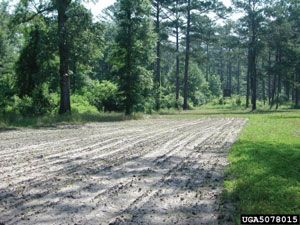Managing Forests to Promote
Game Species
Hunting is a popular recreational activity enjoyed by many Floridians. Game species in Florida that rely on forests to meet at least part of their habitat needs include white-tailed deer, wild turkey, northern bobwhite quail, and gray squirrels.
Management of forests to promote game species can provide both recreational opportunities for landowners and supplemental income through the leasing of hunting rights. Hunting leases are agreements made between hunters and landowners to permit access by hunters to the landowners’ property. As conversion of natural lands to more intensive uses increases throughout the state, hunting leases are growing in popularity and profitability.
General factors that should be given consideration by forest landowners and managers interested in promoting game species include the following:
- Many game species thrive in areas with a great deal of edge habitat (areas where two or more habitat types come into contact with one another). Deer, turkey, and quail often feed extensively in fields with forested perimeters so they can quickly retreat into the forest to escape from predators. Providing extensive edge habitat (such as long, irregular borders between forests and open fields) is a good strategy for promoting many game species.
- Some deciduous trees produce mast (nuts, such as acorns, and fruits, such as black cherries). Mature oaks, beech, and black walnut trees provide essential food in the autumn, a time of year when animal food supplies tend to be limited. By maintaining some mature nut-producing trees and some fruit-producing trees and shrubs you may enhance productivity and survival of game species.
- White-tailed deer, wild turkey, and quail consume a variety of herbaceous (non-woody) plant parts. Forest management practices that promote native vegetation in the herbaceous layer at the forest floor while discouraging dominance of a woody shrub layer (thinning, prescribed burning, disking) are generally beneficial to deer, turkey, and quail.
- Insects and seeds are essential food items for young turkey and quail. Creation of forest openings and encouragement of grasses and other herbaceous vegetation in these areas with full sunlight can increase habitat quality for young birds.
- Food plots can be an effective means of providing additional food resources to game species during those seasons when native food resources are limited. However, food plot maintenance is costly and time-intensive, so attention should always be given first to managing native vegetation and second to providing supplemental food through food plots.

Managing Forests
for Wildlife
- Managing Forests to Promote Game Species
- Managing forests to promote biodiversity
- Coping with damage caused by wildlife
- Sources of assistance for forest landowners
UF Publications
- White-tailed deer of Florida
- White-tailed deer management in Florida part I: Collecting information on herd health
- Establishment of food plots for white-tailed deer in central and south Florida
- A walk on the wild side: 2007 cool-season forage recommendations for wildlife food plots in North Florida
- Comparing fall food plot blends for deer: 2006 update
- Supplemental feeding and food plots for bobwhite quail
- A native growing season forage for wildlife: Teaweed, Sida acuta Burm f.
- Soil fertility management for wildlife food plots


